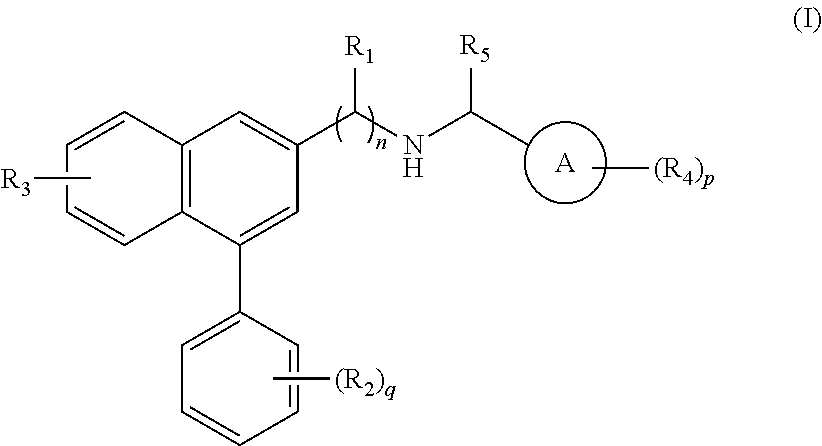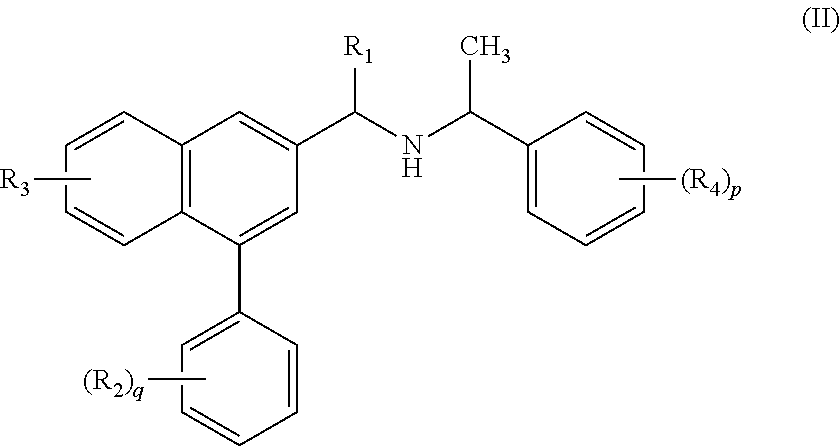Substituted naphthalene compounds as calcium sensing receptor modulators
a calcium sensing receptor and substituted naphthalene technology, applied in the preparation of amino-hyroxy compounds, organic compounds, endocrine system disorders, etc., can solve the problems of insufficient conversion of vitamin d to its active form, insufficient excretion of phosphorous,
- Summary
- Abstract
- Description
- Claims
- Application Information
AI Technical Summary
Benefits of technology
Problems solved by technology
Method used
Image
Examples
example-1
(R)-1-(Naphthalen-1-yl)-N-((4-(4-(trifluoromethyl)phenyl)naphthalen-2-yl) methyl)ethanamine hydrochloride
[0460]
[0461]To a stirred solution of Intermediate-9 (150 mg, 0.500 mmol) and (R)-1-(naphthalen-1-yl) ethanamine (86 mg, 0.500 mmol) in methanol (5 ml) and tetrahydrofuran (10 ml) was added acetic acid (0.029 ml, 0.500 mmol). Reaction mixture was stirred at 25° C. for 4 h. Then acetic acid (0.057 ml, 0.999 mmol) was added followed by addition of NaBH3CN (37.7 mg, 0.599 mmol). Reaction mixture was stirred at 25° C. for 16 hrs. TLC showed completion of reaction. Reaction mixture was quenched with saturated aqueous NaHCO3 (15 ml) and extracted with ethyl acetate (15 ml). Organic layer was dried over sodium sulfate, concentrated to get 0.3 g of crude compound. This compound was purified by column chromatography using 30% ethyl acetate in hexane as a eluent to give 0.2 g of free amine compound as an off white solid.
[0462]This amine was dissolved in dichloromethane (3 ml) and 2M etherea...
example-6
(R)-1-(3-Methoxyphenyl)-N-(1-(4-(4-(trifluoromethyl)phenyl)naphthalen-2-yl) ethyl)ethanamine hydrochloride
[0465]
[0466]Intermediate-16 (0.56 g, 1.782 mmol) was added to a solution of (R)-1-(3-methoxyphenyl)ethanamine (0.808 g, 5.35 mmol) in titanium(IV) isopropoxide (6.26 ml, 21.38 mmol) at 25° C. and resulting suspension was stirred at 90° C. for 16 hrs. Reaction mixture was diluted with methanol (3 ml) and cooled to 0° C. Sodium borohydride (0.202 g, 5.35 mmol) was added lot-wise and reaction mixture was stirred at 0° C. for 10 min. TLC showed completion of reaction. Brine (10 ml) and ethyl acetate (20 ml) were added and precipitated solid was filtered through celite, washed with ethyl acetate (10 ml). The phases were separated and the aqueous phase was extracted with ethyl acetate (5 ml). The combined organic extract was dried over anhydrous sodium sulphate, filtered and concentrated in vacuo to get 0.8 g of the crude residue. This residue was purified by column chromatography ove...
example-24
(R)-Methyl-2-methyl-5-(3-(((1-(naphthalen-1-yl)ethyl)amino)methyl)naphthalen-1-yl)benzoate
[0474]
[0475]To a stirred solution of Intermediate-26 (100 mg, 0.329 mmol) in methanol (4 mL), and THF (4 mL), was added acetic acid (0.019 ml, 0.329 mmol) and (R)-1-(naphthalen-1-yl)ethanamine (56.3 mg, 0.329 mmol). The resulting mixture was stirred at room temperature for 30 minutes. Then, acetic acid (0.038 ml, 0.657 mmol) and NaBH3CN (24.78 mg, 0.394 mmol) was added at 0° C. and the reaction mixture was stirred at room temperature for 16 hours. After completion of reaction, the reaction mixture was concentrated. The residue was partitioned between aq.NaHCO3 (10 ml) and ethyl acetate (15 mL×2). The organic layer was washed with brine (15 mL), dried over anhydrous Na2SO4 and then filtered. The filtrate was concentrated under reduced pressure and resulting residue was purified by column chromatography over silica gel (100-200 mesh) with isocratic elution of 20% ethyl acetate in hexane to afford...
PUM
| Property | Measurement | Unit |
|---|---|---|
| temperature | aaaaa | aaaaa |
| temperature | aaaaa | aaaaa |
| concentration | aaaaa | aaaaa |
Abstract
Description
Claims
Application Information
 Login to View More
Login to View More - R&D
- Intellectual Property
- Life Sciences
- Materials
- Tech Scout
- Unparalleled Data Quality
- Higher Quality Content
- 60% Fewer Hallucinations
Browse by: Latest US Patents, China's latest patents, Technical Efficacy Thesaurus, Application Domain, Technology Topic, Popular Technical Reports.
© 2025 PatSnap. All rights reserved.Legal|Privacy policy|Modern Slavery Act Transparency Statement|Sitemap|About US| Contact US: help@patsnap.com



